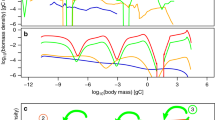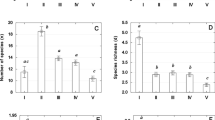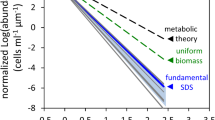Abstract
Food-chain length is an important characteristic of ecological communities1: it influences community structure2, ecosystem functions1,2,3,4 and contaminant concentrations in top predators5,6. Since Elton7 first noted that food-chain length was variable among natural systems, ecologists have considered many explanatory hypotheses1,4,8,9, but few are supported by empirical evidence4,10,11. Here we test three hypotheses that predict food-chain length to be determined by productivity alone (productivity hypothesis)4,10,12,13, ecosystem size alone (ecosystem-size hypothesis)14,15 or a combination of productivity and ecosystem size (productive-space hypothesis)7,16,17,18. The productivity and productive-space hypotheses propose that food-chain length should increase with increasing resource availability; however, the productivity hypothesis does not include ecosystem size as a determinant of resource availability. The ecosystem-size hypothesis is based on the relationship between ecosystem size and species diversity, habitat availability and habitat heterogeneity14,15. We find that food-chain length increases with ecosystem size, but that the length of the food chain is not related to productivity. Our results support the hypothesis that ecosystem size, and not resource availability, determines food-chain length in these natural ecosystems.
This is a preview of subscription content, access via your institution
Access options
Subscribe to this journal
Receive 51 print issues and online access
$199.00 per year
only $3.90 per issue
Buy this article
- Purchase on SpringerLink
- Instant access to full article PDF
Prices may be subject to local taxes which are calculated during checkout



Similar content being viewed by others
References
Pimm, S. L. & Lawton, J. H. The number of trophic levels in ecological communities. Nature 275, 542– 544 (1977).
Carpenter, S. R. & Kitchell, J. F. The Trophic Cascade in Lakes (Cambridge Univ. Press, Cambridge, 1993).
DeAngelis, D. L. Dynamics of Nutrient Cycling and Food Webs (Chapman and Hall, London, 1992).
Pimm, S. L. Food Webs (Chapman and Hall, London, 1982).
Cabana, G. & Rasmussen, J. B. Modelling food chain structure and contaminant bioaccumulation using stable nitrogen isotopes. Nature 372, 255–257 ( 1994).
Kidd, K. A., Schindler, D. W., Hesslein, R. H. & Muir, D. C. G. Effects of trophic position and lipid on organochlorine concentrations in fishes from subarctic lakes in Yukon Territory. Can. J. Fish. Aquat. Sci. 55, 869–881 ( 1998).
Elton, C. Animal Ecology (Sidgwick and Jackson, London, 1927).
Hairston, N. G. Jr & Hairston, N. G. Sr Cause–effect relationships in energy flow trophic structure and interspecific interactions. Am. Nat. 142, 379–411 (1993).
Persson, L., Bengtsson, J., Menge, B. A. & Power, M. A. in Food Webs: Integration of Pattern and Process (eds Polis, G. A. & Winemiller, K. O.) 396–434 (Chapman and Hall, New York, 1996).
Briand, F. & Cohen, J. E. Environment correlates of food chain length. Science 238, 956– 960 (1987).
Sterner, R. W., Bajpai, A. & Adams, T. The enigma of food chain length: absence of theoretical evidence for dynamic constraints. Ecology 78, 2258–2262 (1997).
Kaunzinger, C. M. K. & Morin, P. J. Productivity controls food-chain properties in microbial communities. Nature 395, 495–497 ( 1998).
Oksanen, L., Fretwell, S. D., Arruda, J. & Niemelä, P. Exploitation ecosystems in gradients of primary productivity. Am. Nat. 118, 240–261 ( 1981).
Cohen, J. E. & Newman, C. M. Community area and food-chain length: theoretical predictions. Am. Nat. 138, 1542–1554 (1992).
Holt, R. D. in Species Diversity in Ecological Communities (eds Ricklefs, R. E. & Dchluter, D.) 77–88 (Univ. Chicago Press, Chicago, 1993).
Hutchinson, G. E. Homage to Santa Rosalia; or, why are there so many kinds of animals? Am. Nat. 93, 145–159 ( 1959).
Slobodkin, L. B. Growth and Regulation of Animal Populations (Holt, Rinehart and Wilson, New York, 1961).
Schoener, T. W. Food webs from the small to the large. Ecology 70, 1559–1589 (1989).
Schindler, D. W. Factors regulating phytoplankton production and standing crop in the world's lakes. Limnol. Oceanogr. 23, 478– 486 (1978).
Vander Zanden, M. J., Shuter, B. J., Lester, N. & Rasmussen, J. B. Patterns of food chain length in lakes: a stable isotope study. Am. Nat. 154, 406–416 ( 1999).
Peterson, B. J. & Fry, B. Stable isotopes in ecosystem studies. Ann. Rev. Ecol. Syst. 18, 293–320 (1987).
Minagawa, M. & Wada, E. Stepwise enrichment of 15N along food chains: further evidence and the relation between δ15N and animal age. Geochim. Cosmochim. Acta 48, 1135–1140 (1984).
France, R. L. & Peters, R. H. Ecosystem differences in the trophic enrichment of 13C in aquatic food webs. Can. J. Fish. Aquat. Sci. 54, 1255–1258 (1997).
France, R. L. Differentiation between littoral and pelagic food webs in lakes using carbon isotopes. Limnol. Oceanogr. 40, 1310– 1313 (1995).
Paine, R. T. Food webs: road maps of interactions or grist for theoretical development? Ecology 69, 1648–1654 (1988).
Jenkins, B., Kitching, R. L. & Pimm, S. L. Productivity, disturbance and food web structure at a local spatial scale in experimental container habitats. Oikos 65, 249–255 ( 1992).
Persson, L., Diehl, S., Johansson, L., Andersson, G. & Hamrin, S. F. Trophic interactions in temperate lake ecosystems: a test of food chain theory. Am. Nat. 140, 59–84 (1992).
del Giorgio, P. A. & France, R. L. Ecosystem-specific patterns in the relationship between zooplankton and POM or microplankton δ13C. Limnol. Oceanogr. 41, 359– 365 (1996).
Vollenweider, V. R. A. Das Nährstoffbelastungskonzept als grundlage für den externen eingriff in den eutrophierungsprozeß stehender gewässer und talsperren. Z. Wasser-u. Abswasser-Furschung 12, 46 –56 (1979).
Kling, G. W., Fry, B. & O'Brien, W. J. Stable isotopes and planktonic trophic structure in arctic lakes. Ecology 73, 561– 566 (1992).
Acknowledgements
We thank the New York State Department of Environmental Conservation fisheries biologists and managers, as well as J. Beemer, T. Butler, E. Mills, L. Rudstam, D. Parish, B. Pientka, L. Puth, M. Vogelsang and N. Vochick for their help collecting fish and other samples; K. L. Lovell, J. Burdet and C. Alpha for laboratory and field assistance; and T. E. Dawson, L. O. Hedin, M. H. Olson and L. M. Puth for comments. This research was supported by the Kieckhefer Adirondack Fellowship, the National Science Foundation Research Training Group for Biogeochemistry and Environmental Change at Cornell University and the National Science Foundation Graduate Research Training grant for Human Accelerated Environmental Change at Cornell University and the Institute of Ecosystem Studies.
Author information
Authors and Affiliations
Corresponding author
Rights and permissions
About this article
Cite this article
Post, D., Pace, M. & Hairston, N. Ecosystem size determines food-chain length in lakes. Nature 405, 1047–1049 (2000). https://doi.org/10.1038/35016565
Received:
Accepted:
Issue Date:
DOI: https://doi.org/10.1038/35016565
This article is cited by
-
Food web restoration lags behind biological communities: a case study from a floodplain wetland
Hydrobiologia (2024)
-
Conifers and non-native tree species shift trophic niches of generalist arthropod predators in Central European beech forests
BMC Ecology and Evolution (2023)
-
Walleye and yellow perch resource use in large lakes invaded by spiny water fleas and zebra mussels
Aquatic Ecology (2023)
-
Trophic structure of fish assemblages from oligotrophic tropical rivers: evidence of growing assimilation of autochthonous primary producers with the increase in river dimensions
Aquatic Ecology (2023)
-
Historic trophic decline in New England’s coastal marine ecosystem
Oecologia (2023)
Comments
By submitting a comment you agree to abide by our Terms and Community Guidelines. If you find something abusive or that does not comply with our terms or guidelines please flag it as inappropriate.



